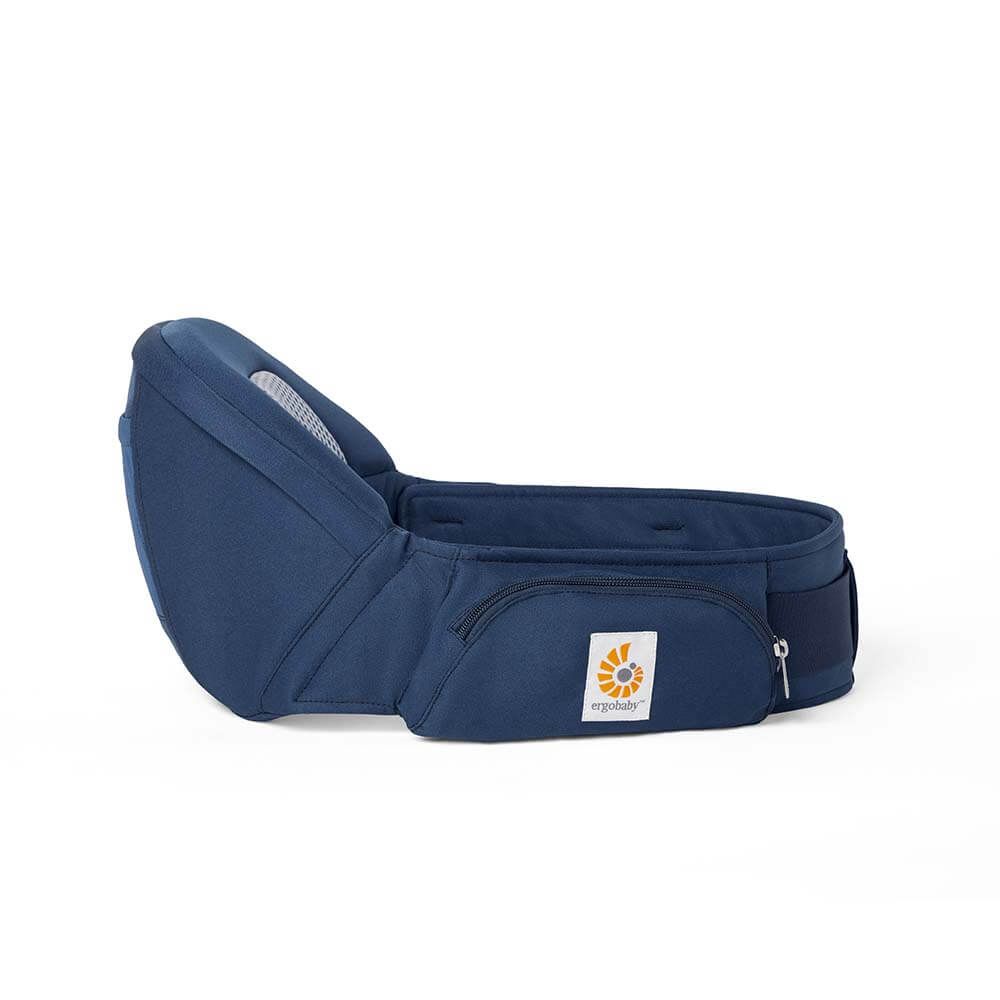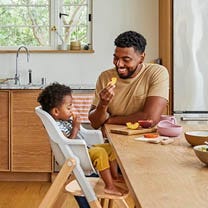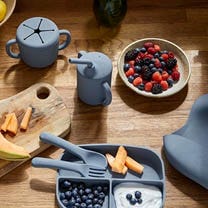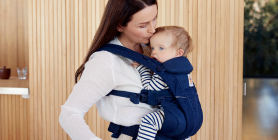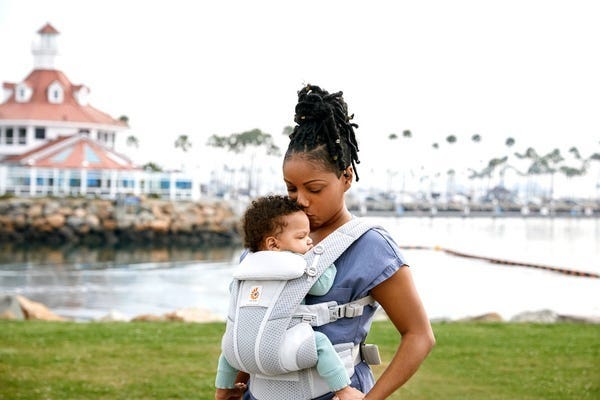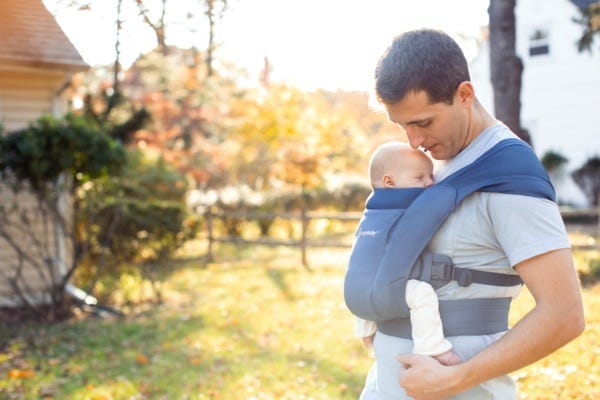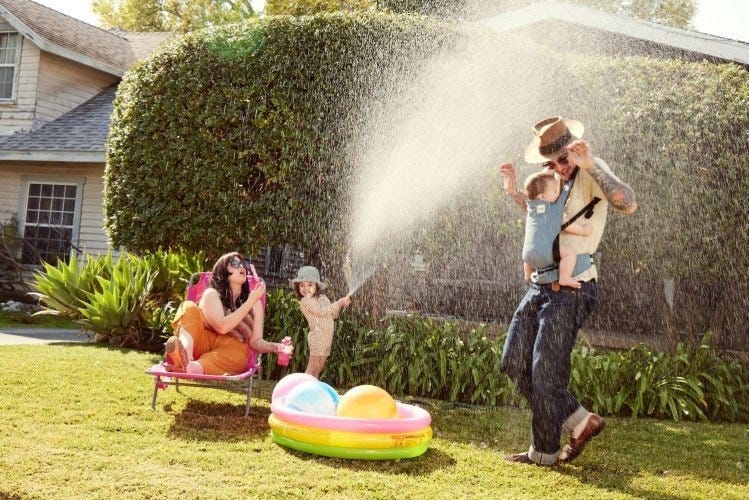Recently, there has become a clear distinction between co-sleeping and what experts now refer to as bed-sharing. In order to decide what is best for your family, it is important to know the difference. According to Attachment Parenting International (API), the definitions are as follows: “Co-sleeping refers to sleeping in ‘close proximity,’ which means the child is on a separate sleep surface in the same room as the parents.” “Bed-sharing, also called the ‘family bed,’ describes a sleep arrangement where the family members sleep on the same surface.” While new parents may feel pressured to have their baby “sleep through the night,” this scenario describes a myth. Frequent waking occurs for myriad reasons, and throughout most of the phases of a baby’s growth and development into childhood. Most parents find it less disruptive to sleep in close proximity to the baby, to accommodate for nighttime feeding and other needs with minimal interruption. In fact, babies often settle back into a deep sleep very easily with a quick feeding and comforting snuggle from a parent. Some parents are encouraged to let the baby “cry it out,” believing that this will teach the baby to self-soothe and eventually train him to sleep on his own. A recent article published on API’s website states that “New research suggests that these techniques can have detrimental physiological effects on the baby by increasing the stress hormone cortisol in the brain, with potential long term effects to emotional regulation, sleep patterns and behavior.” Indeed, proponents of attachment parenting agree that sleeping with a child close is preferable to separating for the night. But bed-sharing has recently come under attack as numerous “studies” have claimed to show a link between bed-sharing and infant death. A closer look at the studies conducted, and the groups sponsoring them, reveals a more complicated picture. According to Dr. Sears, one campaign to encourage crib sleeping is sponsored by the Juvenile Products Manufacturing Association (JPMA); an association of crib manufacturers. This obviously reflects a conflict of interest that cannot be overlooked. In fact, Sears, a widely respected doctor, child-rearing guru, and father, reports that approximately 2,600 cases of SIDS occurred each year in 1999, 2000, and 2001. An additional 180 cases of non-SIDS related infant deaths occurred in an adult bed during those same three years (possibly attributable to suffocation, smothering, and entrapment in furniture or bedding; and a figure meant to discourage bed-sharing). Thus, the number of accidental deaths in an adult bed was only 1.5% of the total cases of SIDS; certainly a figure not significant enough to demand the avid anti-bed-sharing campaign launched by the JPMA and others. TheBabyBond.com, indicates that this JPMA study was indeed suspiciously incomplete, and other studies have illustrated a reduction in SIDS among babies co-sleeping with parents. The crib industry (JPMA) provided a large forum for the Consumer Product Safety Commission (CPSC) to announce this report. Unfortunately, no comparative statistics are provided in their announcements, and even the statistics they report are admittedly anecdotal and irregular. While the report supposedly left out the adult bed deaths that were diagnosed as SIDS (versus accidents), the determination between suffocation and SIDS is often a judgment call. Suffocation in a crib is more often reported as SIDS, while suffocation in an adult bed is reported as "death by adult bed." The actual SIDS statistics were not measured. Why? Several well-designed research studies demonstrate that SIDS is actually reduced in babies co-sleeping along with an aware, protective (non-smoking, non-drug-impaired) mother in a safe bed. Such an announcement would not sell cribs. The numbers in the largest study on co-sleeping around the world suggest that safe co-sleeping reduces SIDS! See graph at bottom. International Child Care Practices Study Another large study on SIDS shows 1/5th the risk of death for sleeping infants simply sharing the room with non-smoking adults. This includes many sleep variations. The rate for sharing bed was not measured directly. New Zealand Cot Death Study. http://thebabybond.com/Cosleeping&SIDSFactSheet.html Practicing safe bed-sharing, however, means abiding by certain guidelines: Avoid excessive alcohol intake or drug use while bed-sharing. Since mothers are usually more in tune with the baby and less likely to roll onto him, the baby should sleep next to his mother rather than between parents. Put the baby to sleep on his back. Keep the baby away from the edge of the bed. When reasonable precautions are taken, bed-sharing is a safe, nurturing, and widely-practiced sleeping choice. A nearby parent is far more likely to be alerted to any changes in the baby’s sleep; including choking, gasping, coughing, and crying, than a parent in another room. In fact, according to a comprehensive article published in Mothering Magazine in 2002, in which worldwide studies and results were considered; “Research shows that infants who sleep in a crib are twice as likely to suffer a sleep related fatality (including SIDS) than infants who sleep in bed with their parents. “ (Dr. Sears) Consider the following facts when choosing a sleep method for your family:
- 95 % of the world sleeps with their baby. In countries where co-sleeping is nearly universal, such as Hong Kong and Japan, SIDS rates are among the lowest on record.
- Co-sleeping babies cry less and sleep more.
- Infants who sleep with their parents under reasonable, safe conditions; either bed-sharing or co-sleeping; have higher survival rates. (Sleeping With Your Baby: A Parent’s Guide to CoSleeping; James J. McKenna; 2007)
- Both babies and mothers sleep better when bed-sharing, as they synchronize their sleep and wake patterns and drift between cycles with minimal interruption. (Dr. Sears, www.askdr.sears.com/html/10/T130400.asp)
- Bed-sharing encourages and facilitates breastfeeding, which is proven to be best for baby’s health.
Bed-sharing and co-sleeping are natural, healthy, and safe choices for parents and their baby. Sleeping in close proximity to the baby is a natural way to promote nurturing and bonding, ensure quality sleep, and build a solid foundation of trust and confidence between parents and their baby. When done properly, bed-sharing is safer than leaving the baby alone, and encourages healthy breastfeeding, breathing, and sleep patterns for babies. http://www.pantley.com/elizabeth/ No-Cry Sleep Solution: Gentle Ways to Help Your Baby Sleep Through the Night by Elizabeth Pantley
There’s something magical about the summer sun, fresh air, and the great outdoors. As a mom, some of my fondest memories are of summertime adventures with my little ones. Whether it's a walk in the park or a hike through a lush forest, these moments are even more special when you have your baby close to you, sharing the experience. In this blog, I’ll explore the joys and benefits of using baby carriers during summer adventures, and how Ergobaby products can make your outdoor excursions even better.
The Benefits of Summer Adventures with Babies
Physical Benefits of Outdoor Adventures
Getting outside with your baby isn't just fun; it’s also incredibly beneficial for both of you. Fresh air and sunshine are great for everyone, but especially for babies and parents. Regular outdoor activities can help improve your baby's sleep patterns and boost their immune system.
For parents, it's a wonderful way to get some light exercise, which is essential for postpartum recovery and overall health.
Emotional Benefits of Getting Outside
Spending time in nature with your baby can strengthen the bond between you. The simple act of holding your baby close, feeling their warmth, and sharing new experiences together can create strong emotional connections. It’s also a wonderful way to reduce stress and improve your mood. When my littles were extra fussy, I’d take a walk around the neighborhood. Even though I don't live in an area with trails and surrounded by nature, simply behind outside changed everything. A little vitamin D does wonders!
Cognitive Development
Nature is a sensory wonderland for babies. The different sights, sounds, and smells can stimulate your baby’s senses and promote cognitive development. Watching leaves rustle, hearing birds chirp, and feeling the texture of a tree bark can all contribute to their learning and development.
All About Baby Carriers for Nature Adventures
Choosing the Right Baby Carrier
When it comes to selecting the best baby carrier for summer adventures, there are several options to consider.
Types of Baby Carriers:
- Wraps: Perfect for newborns, providing a snug and secure fit.
- Slings: Ideal for quick and easy use, offering good ventilation.
- Soft Structured Carriers: Versatile and comfortable for both parent and baby, suitable for longer trips.
Factors to Consider:
- Baby’s Age and Weight: Ensure the carrier is appropriate for your baby’s size and weight. For example, Ergobaby’s Embrace Newborn Carrier is perfect for the fourth trimester where baby is small and you’re looking for an easy way to stay close. As they grow, you’ll want to upgrade to an all-position carrier that’s meant for growing babies.
- Parent’s Comfort and Ergonomics: Look for carriers with padded shoulder straps and lumbar support if you’re planning on longer outings.
- Ease of Use: Choose a carrier that is easy to put on and take off.
- Climate and Breathability: Opt for carriers made of breathable fabrics to keep you and your baby cool in hot weather.
Safety Tips:
- Proper Positioning: Ensure your baby is seated correctly, with their legs in an "M" position and their head should be close enough to kiss.
- Checking for Wear and Tear: Regularly inspect your carrier for any signs of damage.
- Ensuring Adequate Support: Make sure the carrier provides proper support for your baby’s head and neck.
Exploring Nature with a Baby Carrier
Ideal Spots for a Nature Walk with Baby
- Parks and Gardens: Great for leisurely walks and picnics.
- Nature Trails and Forests: Perfect for more adventurous outings.
- Beaches and Lakesides: Wonderful for enjoying the water and sand, with the right carrier.
Activity Ideas
- Hiking: Enjoy a scenic hike with a hiking baby carrier that offers support and storage.
- Bird Watching: Use your carrier to keep your baby close while you explore and observe wildlife.
- Picnics: A carrier can free up your hands, making it easier to carry picnic supplies.
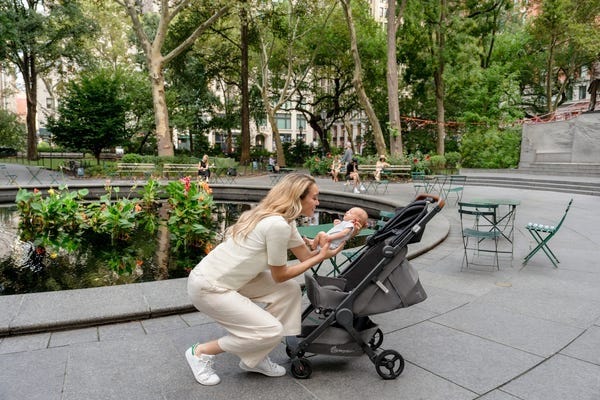

Advantages of Using Strollers for Nature Adventures
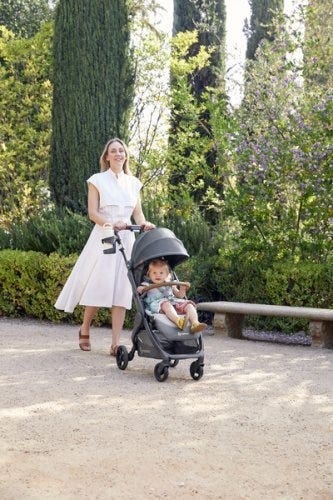

While baby carriers are fantastic for mobility and closeness, depending on the adventure of choice you might want to be a stroller along too.
There are a LOT of baby stroller options on the market. So we understand how confusing it can be to choose the one that’s right for your family. Not only are there a variety of brands, but a variety of strollers that serve different purposes.
There are a few types of strollers on the market:
- Full-sized stroller: This is typically the stroller parents thing of buying for all its versatility.
- Lightweight or umbrella stroller:These compact strollers are perfect for on-the-go adventures.
- Jogging stroller: Designed for parents who want to combine fitness with outdoor adventures.
- Double stroller: Designed for parents with multiple kids, especially twins.
- Car seat carrier: These strollers connect to a specific car seat. We don't typically recommend these as they can be unsafe for baby and uncomfortable for parents who are pushing.
Learn more about the types of strollers and which one would be best for you.
Benefits of Bringing a Stroller
- Storage Space for Gear: Ample room for carrying all your essentials like a diaper bag, beach toys and more.
- Shade and Weather Protection: Built-in canopies to shield your baby from the sun when they are lounging.
- Options: If you have more than one kid, you can stroll with one and carry the other. Or, if you’re getting warm or your little one is getting fussy, you can switch up their position from stroller to carrier or vice versa.
Safety Tips for Strollers
- Ensure your stroller is in good working condition. Make sure buckles are still buckling and that there are no rips or holes that could compromise your baby’s safety.
- Use sunshades or bug nets to protect your little one’s skin.
- Securing the baby properly: always buckle up your baby for safety even if you think they are old enough to go without the buckle.
Combining Baby Carriers and Strollers
For the ultimate flexibility, consider using both a baby carrier and a stroller on your outings.
Combining both options allows you to adapt to different situations. Use the carrier for more rugged trails and switch to the stroller for smoother paths or when your baby needs a nap.
Transition Tips
- Smooth Transitions: Plan stops where you can easily switch from carrier to stroller.
- Pack Light: Only bring essentials to make transitions easier.
Tips for a Successful Adventure
Planning Ahead
- Route Planning: Choose baby-friendly trails and parks. Check local mom groups or outdoor groups and get recommendations for the best outings for kids.
- Check Weather Conditions: Avoid extreme heat or unpredictable weather. Even with our most breathable carriers, when it’s hot, it’s hot. And having two bodies against each other in the heat will be naturally hot and sticky already.
- Packing Checklist: Include diapers, snacks, water, sunscreen, and a first-aid kit. These all-position carriers have storage pockets where you can fit some of the items easily!
- Stay Hydrated and Nourished: Pack healthy snacks to keep energy levels up and bring plenty of water for both you and baby.
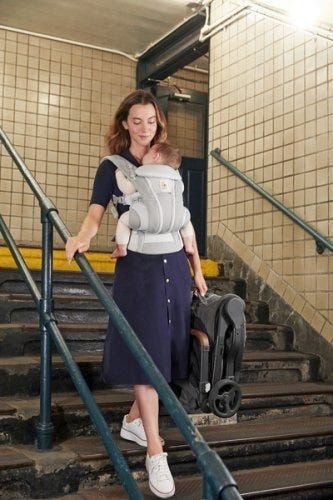

Summer adventures with your baby are a wonderful way to create lasting memories and enjoy the beauty of nature together. From baby carriers to strollers, Ergobaby products are designed to provide comfort and ease for both you and your little one. So, gear up, get outside, and explore the world with your baby by your side.
Ready to embark on your own summer adventures? Check out Ergobaby’s range of baby carriers and strollers to find the perfect match for your family’s needs. Visit our website today and start planning your next outdoor excursion!





